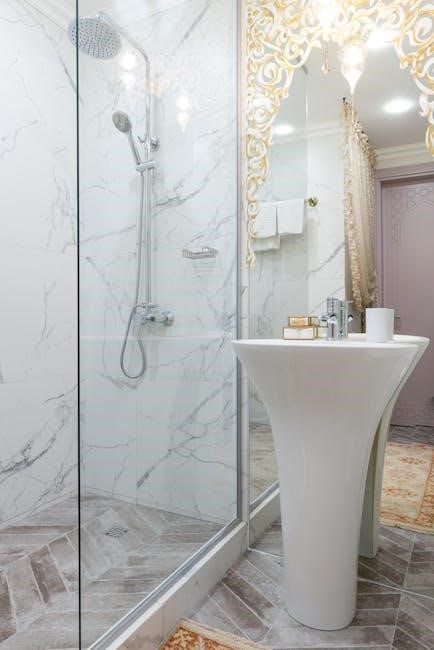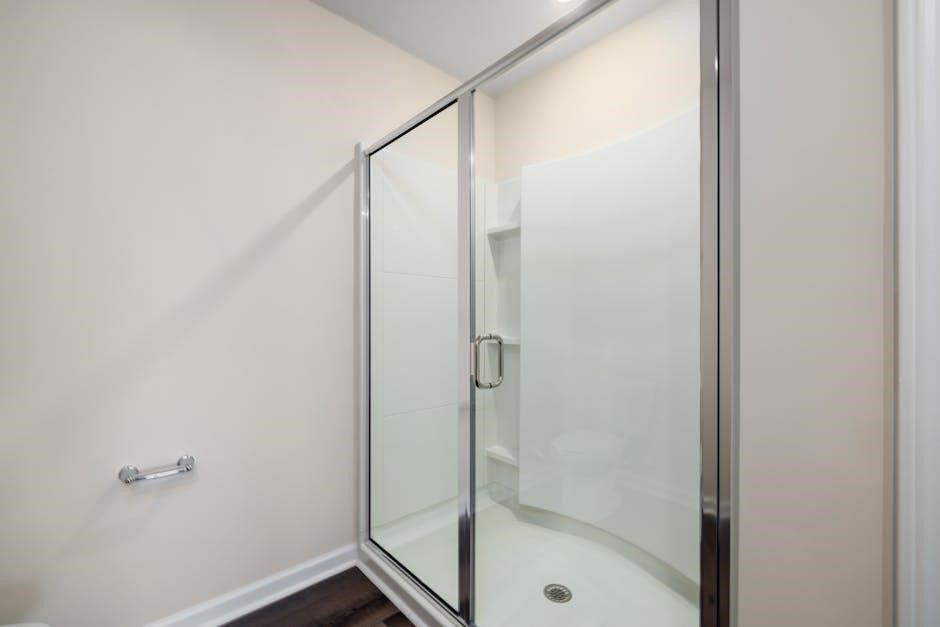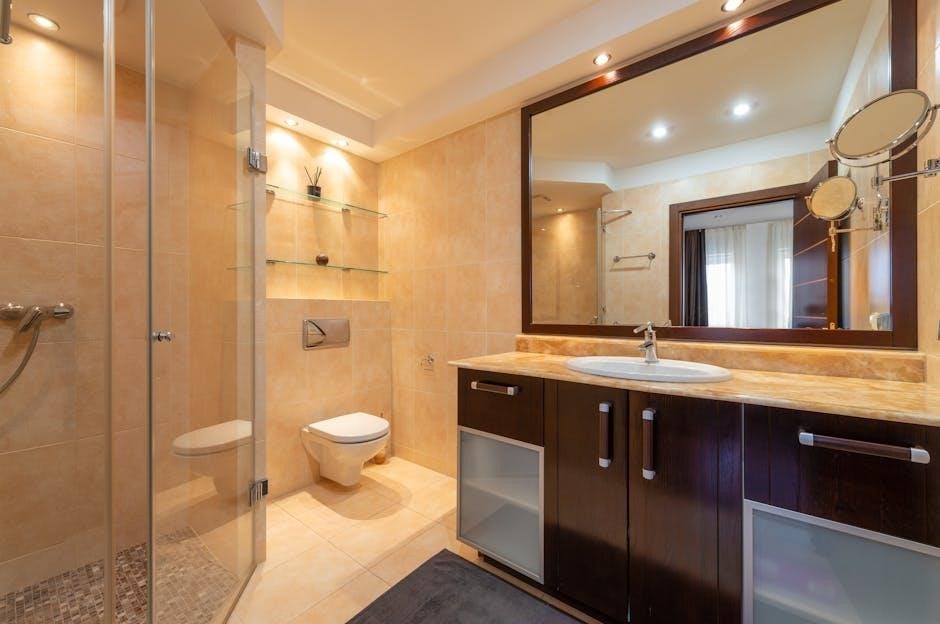A bottom guide is a vital component ensuring smooth operation and alignment of sliding shower doors, preventing misalignment and enhancing stability. Made from durable materials, it guarantees long-lasting performance.
What is a Bottom Guide?
A bottom guide is a small, essential component designed to facilitate smooth operation of sliding shower doors. It is typically a plastic or nylon piece mounted at the base of the door, ensuring proper alignment and preventing wobbling or misalignment. This guide helps the door move seamlessly along its track, maintaining stability and preventing it from swinging out of place. It is a crucial part of the door’s hardware, especially in trackless systems, where no bottom track is present. Its durable construction ensures long-lasting performance and quiet operation.
The Importance of the Bottom Guide in Sliding Shower Doors

The bottom guide plays a critical role in ensuring the proper functioning and stability of sliding shower doors. It prevents the door from wobbling or misaligning, which could lead to operational issues or safety hazards. By keeping the door firmly on its track, the bottom guide enhances the overall performance and longevity of the shower door system. Its presence also reduces wear and tear on other components, ensuring a smooth and quiet operation. This small but essential part is vital for maintaining both the functionality and aesthetic appeal of the shower enclosure.

The Purpose and Function of a Bottom Guide
The bottom guide ensures proper alignment and smooth movement of sliding shower doors, preventing misalignment and wear while maintaining stability and ease of operation.
Why is the Bottom Guide Necessary?
The bottom guide is essential for maintaining proper alignment and smooth operation of sliding shower doors. It prevents doors from swinging or derailing, ensuring stability and functionality. By guiding the door along its track, it reduces wear and tear, minimizing the risk of damage. Proper installation and maintenance of the bottom guide are crucial for optimal performance and longevity, ensuring your shower door operates effortlessly for years to come.
How the Bottom Guide Contributes to Door Stability
The bottom guide plays a critical role in ensuring sliding shower doors remain stable and secure. By maintaining proper alignment, it prevents doors from derailing or swinging excessively. This component absorbs lateral forces, keeping the door on track and reducing the risk of misalignment. Its presence ensures smooth operation, minimizing wear on rollers and hinges. A stable door not only enhances safety but also extends the lifespan of the shower door system, providing reliable performance over time.
Types of Bottom Guides for Sliding Shower Doors
Bottom guides come in adjustable and fixed designs, offering flexibility or permanence. Materials vary, including nylon, metal, and plastic, catering to different door styles and durability needs.
Adjustable vs. Fixed Bottom Guides
Adjustable bottom guides offer flexibility, allowing users to fine-tune alignment as needed, while fixed guides provide a permanent, stable solution. Adjustable guides are ideal for doors that may shift over time due to wear or uneven surfaces, enabling precise adjustments for smooth operation. Fixed guides, however, are simpler in design and require no maintenance once installed. Both types ensure proper door alignment but cater to different user preferences and bathroom conditions.
Material choices, such as nylon or metal, further enhance their performance and longevity, making them suitable for various shower door setups.
Material Options for Bottom Guides
Bottom guides for sliding shower doors are available in various materials, each offering unique benefits. Nylon is a popular choice due to its durability and resistance to rust, making it ideal for moist bathroom environments. Metal guides, such as stainless steel, provide exceptional strength and longevity, ensuring stability even with heavy use. Other options include plastic and composite materials, which are lightweight and cost-effective. High-quality guides often feature a sleek design that complements modern bathroom aesthetics while ensuring smooth door operation and alignment.

Installation and Alignment of the Bottom Guide
Proper installation and alignment of the bottom guide ensure smooth sliding and stability. Adjustments may require tools, and secure fastening prevents misalignment and door wobble.
How to Properly Install a Bottom Guide
Begin by measuring the shower opening at the top, middle, and bottom, using the smallest measurement for accuracy. Position the bottom guide along the shower floor, ensuring it is level using a spirit level tool. Mark the screw positions and drill pilot holes to avoid damage. Secure the guide with screws, following manufacturer instructions for specific models. Test the door’s smooth operation post-installation and ensure the guide is tightly fastened for stability. Regular cleaning is recommended to maintain optimal functionality.
Alignment Tips for Optimal Performance

Ensure the bottom guide is properly aligned with the shower door track for smooth operation. Use a spirit level to verify the guide is level and plumb. Check the door’s movement by sliding it gently, making sure it glides without catching or wobbling. Adjust the rollers or guide position as needed to achieve proper alignment. Keep the track clean and free from debris to maintain optimal performance. Regularly inspect and tighten screws to prevent misalignment caused by wear and tear over time.

Common Issues and Solutions
Common issues include wear, misalignment, and debris buildup. Solutions involve cleaning the track, adjusting the guide, and replacing worn parts to restore smooth operation.
Wear and Tear on the Bottom Guide
Wear and tear on the bottom guide can lead to misalignment and instability of sliding shower doors. Over time, the guide may show signs of friction damage or debris accumulation. Moisture and cleaning chemicals can accelerate deterioration. Regular inspection and cleaning are essential to prevent excessive wear. If the guide becomes worn, it may need to be replaced to maintain smooth door operation and prevent further damage. Addressing wear early ensures continued stability and functionality of the shower door system.
How to Fix Misalignment Issues
Misalignment of sliding shower doors can often be corrected by adjusting the bottom guide or the door rollers. Start by checking the alignment using a spirit level. If the door is uneven, adjust the rollers by loosening the screws and repositioning them. Ensure the bottom guide is clean and free of debris, as obstructions can cause misalignment. If issues persist, consider tightening or replacing worn-out components. Proper alignment ensures smooth operation and prevents further damage to the door or frame.
Maintenance and Cleaning of the Bottom Guide
Regular cleaning of the bottom guide is essential to ensure smooth door operation. Use a damp cloth and mild detergent to remove dirt and soap scum buildup.
Best Practices for Cleaning the Bottom Guide
Regular cleaning ensures optimal performance and longevity of the bottom guide. Use a soft, damp cloth with mild detergent to gently remove dirt, soap scum, and mineral deposits. Avoid harsh chemicals or abrasive cleaners that may damage the material. Dry the guide thoroughly after cleaning to prevent water spots. For tougher grime, a small brush can be used to scrub crevices. Inspect the guide for wear or misalignment and lubricate moving parts if necessary. Cleaning maintains smooth door operation and prevents corrosion or damage.
When to Replace the Bottom Guide
Replace the bottom guide when it shows visible wear, such as cracks, rust, or misalignment. If the guide is damaged or loose, it can cause the door to wobble or slide unevenly. Look for signs like difficulty in sliding the door smoothly or excessive noise. Replace it immediately if water leaks due to misalignment or if the guide no longer holds the door properly. Delaying replacement can lead to further damage to the door or surrounding areas. Ensure stability and proper functionality by replacing it promptly when issues arise.
The Role of the Bottom Guide in Safety and Stability
The bottom guide enhances safety and stability by keeping the shower door properly aligned and preventing wobbling, ensuring smooth operation and reducing the risk of accidents.
How the Bottom Guide Enhances Safety
The bottom guide significantly enhances safety by stabilizing the shower door, preventing wobbling or misalignment. This reduces the risk of accidents, especially in wet conditions. By keeping the door securely on track, it ensures smooth operation and minimizes the chance of the door swinging unpredictably. Additionally, the guide supports the door’s weight, distributing force evenly to prevent breakage. Its role in maintaining alignment also ensures the door closes properly, reducing gaps that could lead to slips or falls, thus promoting a safer bathroom environment for all users.
Ensuring Long-Term Stability with the Bottom Guide
The bottom guide plays a crucial role in ensuring the long-term stability of sliding shower doors by maintaining proper alignment and smooth operation. It supports the door’s weight, preventing wobbling and misalignment, and is typically constructed from durable materials like nylon to resist wear and tear. Regular cleaning and proper installation are essential for optimal performance. By keeping the door securely on track, the bottom guide extends its lifespan, ensuring years of reliable service in wet bathroom environments.
Choosing the Right Bottom Guide for Your Shower Door
Selecting the correct bottom guide ensures optimal performance and longevity. Consider door type, material, and size for compatibility. Durable options like nylon are ideal for wet environments.
Factors to Consider When Selecting a Bottom Guide

When choosing a bottom guide, consider your shower door type, material, and size. Ensure compatibility with framed or frameless designs. Durable materials like nylon or metal are ideal for longevity. Measure your door’s thickness and track width for proper fit. Adjustability is key for alignment, while corrosion-resistant finishes suit moist environments. Prioritize guides designed for your door’s weight and movement style. Lastly, check for brand reputation and warranty to ensure reliability and long-term performance.
Matching the Bottom Guide to Your Door Type
Ensure the bottom guide aligns with your shower door type, whether framed, frameless, or trackless. Framed doors often have built-in guides, while frameless doors may require separate, adjustable guides. Trackless systems eliminate the need for bottom guides, relying on top rollers. Always consider door weight, size, and material when selecting. For framed doors, opt for guides with screws, while frameless doors may need adhesive or clamp-on solutions. Check manufacturer specifications for compatibility to ensure smooth operation and longevity.
The bottom guide is essential for sliding shower doors, ensuring stability, alignment, and smooth operation. Proper installation and maintenance are key to its longevity and functionality.
The bottom guide plays a crucial role in maintaining the alignment and stability of sliding shower doors. It prevents the door from wobbling or veering off track, ensuring smooth operation. Typically made of durable materials like nylon or metal, the guide is designed to withstand regular use. Its primary function is to keep the door centered and secure, preventing misalignment issues. By providing consistent support, the bottom guide enhances the overall performance and longevity of the shower door system, ensuring a safe and reliable user experience.
Final Tips for Maintaining Your Sliding Shower Door
To ensure your sliding shower door operates smoothly, regularly clean the bottom guide to prevent debris buildup. Inspect it periodically for wear and tear, replacing it if necessary. Lubricate the rollers to maintain smooth movement and check the alignment to avoid misalignment issues. By following these tips, you can extend the lifespan of your shower door and keep it functioning like new. Proper maintenance ensures safety, stability, and a hassle-free user experience.

Be First to Comment